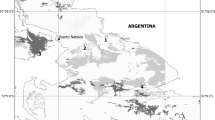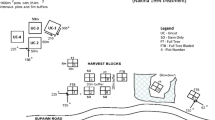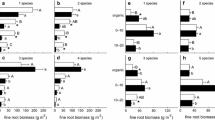Abstract
We investigated the relationship between plant diversity and ecological function (production and nutrient cycling) in tropical tree plantations. Old plantations (65–72 years) of four different species, namely Araucaria cunninghamii, Agathis robusta, Toona ciliata and Flindersia brayleyana, as well as natural secondary forest were examined at Wongabel State Forest, in the wet tropics region of Queensland, Australia. Two young plantations (23 years) of Araucaria cunninghamii and Pinus caribaea were also examined. The close proximity of the older plantations and natural forests meant they had similar edaphic and climatic conditions. All plantations had been established as monocultures, but had been colonised by a range of native woody plants from the nearby rainforest. The extent to which this had occurred varied with the identity of the plantation species (from 2 to 17 species in 0.1 ha blocks). In many cases these additional species had grown up and joined the forest canopy. This study is one of the few to find a negative relationship between overstorey plant diversity and productivity. The conversion of natural forest with highly productive, low-diversity gymnosperm-dominated plantations (young and old Araucaria cunninghamii and Pinus caribaea) was found to be associated with lower soil nutrient availability (approximately five times less phosphorus and 2.5 times less nitrogen) and lower soil pH (mean = 6.28) compared to the other, less productive plantations. The dominant effects of two species, Araucaria cunninghamii and Hodgkinsonia frutescens, indicate that ecosystem functions such as production and nutrient availability are not determined solely by the number of species, but are more likely to be determined by the characteristics of the species present. This suggests that monoculture plantations can be used to successfully restore some functions (e.g. nutrient cycling and production), but that the level to which such functions can be restored will depend upon the species chosen and site conditions.




Similar content being viewed by others
References
Aarssen LW (1997) High productivity in grassland ecosystems: effects by species diversity or productive species? Oikos 80:183–184
Ash J (1983) Growth rings in Agathis robusta and Araucaria cunninghamii from tropical Australia. Aust J Bot 31:269–275
Balvanera P, Aguirre E (2006) Tree diversity, environmental heterogeneity, and productivity in a Mexican tropical dry forest. Biotropica 38:479–491
Binkley D (1984) Ion-exchange resin bags—factors affecting estimates of nitrogen availability. Soil Sci Soc Am J 48:1181–1184
Binkley D, Matson P (1983) Ion-exchange resin bag method for assessing forest soil-nitrogen availability. Soil Sci Soc Am J 47:1050–1052
Boland DJ et al. (1997) Forest trees of Australia. CSIRO Publishing, Collingwood, VIC, Australia
Bolleter WT, Bushman CJ, Tidwell MD (1961) Spectrophotometric determination of ammonium as indophenol. Anal Chem 33:592–594
Cardinale BJ et al. (2006) Effects of biodiversity on the functioning of trophic groups and ecosystems. Nature 443:989–992
Carney KM, Matson PA, Bohannan BJ (2004) Diversity and composition of tropical soil nitrifiers across a plant diversity gradient and among land-use types. Ecol Lett 7:684–694
Caspersen JP, Pacala SW (2001) Successional diversity and ecosystem function. Ecol Res 16:895–903
Connell JH (1978) Diversity in tropical rain forests and coral reefs. Science 199:1302–1310
Connell JH, Slatyer RO (1977) Mechanisms of succession in natural communities and their role in community stability and organization. J Ecol 111:1119–1144
Crawley MJ, Harral JE (2001) Scale dependence in plant diversity. Science 291:864–868
Darwin C (1859) The origin of species by means of selection. Murray, London
Dobson AP, Bradshaw AD, Baker AJM (1997) Hopes for the future: restoration ecology and conservation biology. Science 277:515–522
Erskine PD, Bergstorm DM, Schmidt S, Stewart G, Tweedie CE, Shaw J (1998) Subantartic Macquarie Island—a model ecosystem for studying animal derived nitrogen sources using 15N natural abundance. Oecologia 117:187–193
Erskine P, Lamb D, Bristow M (2006) Tree species diversity and ecosystem function: can tropical multi-species plantations generate greater productivity? For Ecol Manag 233:205–210
Ewel J, Mazzarino MJ, Berish CW (1991) Tropical soil fertility changes under monocultures and successional communities of different structure. Ecol Appl 3:289–302
Hattenschwiler S (2005) Effects of tree species diversity on litter quality and decomposition. In: Scherer-Lorenzen M, Korner C, Schulze ED (eds) Forest diversity and function: temperate and boreal systems. Springer, Berlin, pp 149–162
Hector A (1998) The effect of diversity on productivity: detecting the role of species complementarity. Oikos 82:597–599
Hector A et al. (1999) Plant diversity and productivity experiments in European grasslands. Science 286:1123–1127
Hooper DU et al. (2005) Effects of biodiversity on ecosystem functioning: a consensus of current knowledge. Ecol Monogr 75:3–35
Hughes JB, Petchey OL (2001) Merging perspectives on biodiversity and ecosystem function. Trends Ecol Evol 16:222–227
Huston M (1980) Soil nutrients and tree species richness in Costa-Rican Forests. J Biogeogr 7:147–157
Huston M (1997) Hidden treatments in ecological experiments: re-evaluating the ecosystem function of biodiversity. Oecologia 110:449–460
Huston MA et al. (2000) No consistent effect of plant diversity on productivity. Science 289:1255
Kaiser J (2000) Rift over biodiversity divides ecologists. Science 289:1282–1283
Keenan R, Lamb D, Woldring O, Irvine T, Jensen R (1997) Restoration of plant biodiversity beneath tropical tree plantations in Northern Australia. For Ecol Manag 99:117–131
Kelty MJ (1992) Comparative productivity of monocultures and mixed-species stands. In: Kelty MJ, Larson BC, Oliver CD (eds) The ecology and silviculture of mixed-species forests. Kluwer, Dordrecht, pp 125–141
Laffan MD (1988) Soils and land use on the Atherton Tableland, North Queensland. CSIRO, Melbourne
Lamb D (1998) Large-scale ecological restoration of degraded tropical forest lands: the potential role of timber plantations. Restor Ecol 6:271–279
Lamb D, Gilmour D (2003) Rehabilitation and restoration of degraded forests. IUCN and WWF, Gland, Switzerland
Loreau M (1998) Biodiversity and ecosystem function: a mechanistic model. Proc Natl Acad Sci 95:5632–5636
Loreau M et al. (2001) Biodiversity and ecosystem functioning: current knowledge and future challenges. Science 294:804–808
Lugo AE (1992) Comparison of tropical tree plantations with secondary forests of similar age. Ecol Monogr 62:1–41
Mabi Forest Working Group (2001) Vanishing vegetation of far North Queensland Mabi (5b) Forest. http://www.treat.net.au/mabi/Mabi_Forest.pdf. Cited 30 August 2007
Magurran AE (1988) Ecological diversity and its measurement. Chapman and Hall, London
Mittelbach GG et al. (2001) What is the observed relationship between species richness and productivity? Ecology 82:2381–2396
Mo J, Brown S, Peng S, King G (2003) Nitrogen availability in disturbed, rehabilitated and mature forests of tropical China. For Ecol Manag 175:573–583
Mouquet N, Moore JL, Loreau M (2002) Plant species richness and community productivity: why the mechanisms that promotes coexistence matters. Oikos 5:56–65
Naeem S, Wright JP (2003) Disentangling biodiversity effects on ecosystem functioning: deriving solutions to a seemingly insurmountable problem. Nature 6:567–579
Naeem S, Thompson LJ, Lawler SP, Lawton JH, Woodfin RM (1994) Declining biodiversity can alter the performance of ecosystems. Nature 368:734–736
Ohno T, Zibilske LM (1991) Determination of low concentrations of phosphorous in soil extracts using Malachite green. Soil Sci Soc Am J 55:892–895
Parrotta J (1992) The role of plantation forests in rehabilitating degraded tropical ecosystems. Agri Eco Envir 41:115–133
Parrotta J (1995) Influence of overstorey composition on understorey colonization by native species in plantations on a degraded tropical site. J Veg Sci 6:627–636
Pfisterer AB, Schmid B (2002) Diversity-dependent production can decrease the stability of ecosystem functioning. Nature 416:84–86
Pretzsch H (2005) Diversity and productivity in forests: evidence from long-term experimental plots. In: Scherer-Lorenzen M, Korner C (eds) Forest diversity and function, vol 176. Springer, Berlin, pp 41–64
Prescott CE (2002) The influence of the forest canopy on nutrient cycling. Tree Physiol 22:1193–1200
Reich P et al. (2001) Plant diversity enhances ecosystem responses to elevated CO2 and nitrogen deposition. Nature 410:809–812
Reich PB et al. (2005) Linking litter calcium, earthworms and soil properties: a common garden test and 14 tree species. Ecol Lett 8:811–818
Rothe A, Binkley D (2001) Nutritional interactions in mixed species forests: a synthesis. Can J For Res 31:1855–1870
Satoo T, Madgwick HAI (1982) Forest biomass. Martinus Nijhoff/Dr W. Junk, The Hague
Sayer J, Chokkalingam U, Poulsen J (2004) The restoration of forest biodiversity and ecological values. For Ecol Manage 201:3–11
Schlapfer F, Schmid B (1999) Ecosystem effects of biodiversity: a classification of hypotheses and exploration of empirical results. Ecol Appl 9:893–912
Schwartz MW, Brigham CA, Hoeksema JD, Lyons KG, Mills MH, van Mantgem PJ (2000) Linking biodiversity to ecosystem function: implications for conservation ecology. Oecologia 122:297–305
Smith CK, Gholz HL, Oliveira F (1998) Soil nitrogen dynamics and plant-induced soil changes under plantations and primary forest in lowland Amazonia, Brazil. Plant Soil 200:193–204
Symstad AJ, Tilman D (2001) Diversity loss, recruitment limitation, and ecosystem functioning: lessons learned from a removal experiment. Oikos 92:424–435
Tilman D, Downing JA (1994) Biodiversity and stability in grasslands. Nature 367:363–364
Tilman D, Wedin D, Knops J (1996) Productivity and sustainability influenced by biodiversity in grassland ecosystems. Nature 379:718–721
Tilman D, Knops J, Wedin D, Reich P, Ritchie M, Siemann E (1997a) The influence of functional diversity and composition on ecosystem processes. Science 277:1300–1302
Tilman D, Lehman C, Thomson K (1997b) Plant diversity and ecosystem productivity: theoretical considerations. Proc Natl Acad Sci USA 94:1857–1861
Tinker P (1984) The role of micro-organisms in mediating and facilitating the uptake of plant nutrients from soil. Plant Soil 76:77–91
Troumbis AY, Memtsas D (2000) Observational evidence that diversity may increase productivity in Mediterranean shrublands. Oecologia 125:101–108
Vandermeer JH, Lawrence D, Symstad AJ, Hobbie S (2002) Effect of biodiversity on ecosystem functioning in managed ecosystems. In: Loreau M, Naeem S, Inchausti P (eds) Biodiversity and ecosystem functioning, synthesis and perspectives. Oxford University Press, Oxford, pp 221–233
Vanveldhoven PP, Mannaerts GP (1987) Inorganic and organic phosphate measurements in the nanomolar range. Anal Biochem 161:45–48
Vila M, Vayreda J, Gracia C, Ibanez JJ (2003) Does tree diversity increase wood production in pine forests? Oecologia 135:299–303
Vila M, Vayreda J, Comas L, Ibanez JJ, Mata T, Obon B (2007) Species richness and wood production: a positive association in Mediterranean forests. Ecol Lett 10:241–250
Waide RB, Willig MR, Steiner CF, Mittelbach GG, Gough L, Dodson SI, Juday GP, Parmenter R (1999) The relationship between productivity and species richness. Annu Rev Ecol Syst 30:257–300
Walker BH (1992) Biodiversity and ecological redundancy. Conserv Biol 6:18–23
Wardle DA, Zackrisson O, Hornberg G, Christiane G (1997) The influence of island area on ecosystem properties. Science 277:1296–1299
Webb LJ, Tracey JG, Williams WT (1984) A floristic framework of Australian rainforest. Aust J Ecol 9:169–198
Wood ED, Armstrong FA, Richards FA (1967) Determination of nitrate in sea water by cadmium-copper reduction to nitrite. J Mar Biol Ass UK 47:23–28
Yao H, He Z, Wilson M, Campbell CD (2000) Microbial biomass and community structure in a sequence of soils with increasing fertility and changing land use. Microb Ecol 40:223–237
Acknowledgments
We would like to thank Mark Hunt and Nick Kelley from the Queensland Department of Primary Industries for their support financially and operationally with the field study component of this project. We would also like to thank Tony Irvine, Mila Bristow and Kerry Hanrahan (Department of Primary Industries, Forest Operations) for their assistance and expertise, as well as two anonymous reviewers whose comments greatly improved a previous draft of this document. Finally, we would like to thank Martina Langi, whose work on rainforest plantations in Northern Queensland sparked the idea for our separate study. We declare that this study complies with the current laws of Australia, where it was performed.
Author information
Authors and Affiliations
Corresponding author
Electronic supplementary material
Below is the link to the electronic supplementary material.
Rights and permissions
About this article
Cite this article
Firn, J., Erskine, P.D. & Lamb, D. Woody species diversity influences productivity and soil nutrient availability in tropical plantations. Oecologia 154, 521–533 (2007). https://doi.org/10.1007/s00442-007-0850-8
Received:
Accepted:
Published:
Issue Date:
DOI: https://doi.org/10.1007/s00442-007-0850-8




